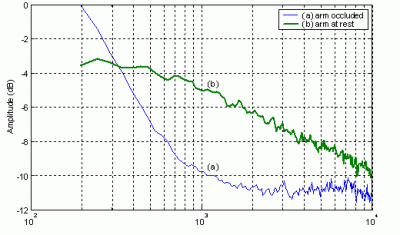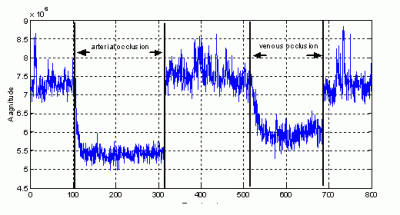Conventional laser Doppler flowmeters (LDF) measure blood flow in skin. In this research, we attempt to measure blood flow in the deeper underlying muscle. The main noticeable difference required for a flowmeter for muscle is the larger spacing between the emitter and detector. Previous research has shown that the depth at which the properties of tissues can be measured is proportional to the spacing between the emitter and detector. We developed a LDF monitor system based on coherent light source (780nm) and an avalanche photodiode (Hamamatsu C5460 ) detector.
Preliminary experiments have been carried out to verify the LDF system performance. The emitter and detector (400/430 micron fibres with APD), with a spacing of 2 cm, were fixed on the forearms of adult volunteers. The detected photocurrent signals were recorded throughout the whole experiment. The arm was first at a resting state for 1 minute and 40 seconds. Subsequently, a sphygmomanometer cuff, surrounding the bicep, was rapidly inflated to 180 mmHg to occlude the surrounding arteries and veins. This occlusion was then held for 3 minutes. The cuff was then rapidly deflated and the arm rested allowed to return to equilibrium over 3 minutes. The cuff was then rapidly inflated again but this time only to 40 mmHg to occlude venous outflow. This occlusion also lasted for 3 minutes. Following deflation of the cuff, the arm was rested for another 2 minutes. Figure 1 depicts the detected photocurrent spectra obtained when (a) the blood flow to the arm was occluded, and (b) at rest.

Figure 1. Detected photocurrent spectra: (a) arm occluded; (b) at rest
The blood flow in the resting arm is of course faster than that of an occluded arm where residual blood movement would be from pressure equilibrium between arteries and veins, plus residual blood flow into the arm through the bones. It can be seen that with normal flow, the magnitudes of the frequency components are reduced at low frequencies and increased at high frequencies. This is in total agreement with both theory and experimental observations in the literatures. Using the frequency weighted algorithm proposed by Bonner and Nossal [1], a blood flow related parameter was calculated and this is shown in Figure 2 for one experiment. The reductions in flow due to the occlusions can be clearly seen. The figure also indicates the different flow values introduced by arterial (very slow flow) and venous (slow flow) occlusions. The same experiment was carried out on 4 subjects, similar results being obtained in all cases. These preliminary tests indicate that the LDP monitor, interfacing hardware and software, and signal processing algorithms all work satisfactorily.

Figure 2. Blood flow related parameters showing variations of blood flow
References
- Bonner R. and Nossal R., "Model for laser Doppler measurements of blood flow in tissue."Applied Optics (1981) 20:2097-2107 [URL]
 Close
Close

